![]()
![]()
![]()
Use LEFT and RIGHT arrow keys to navigate between flashcards;
Use UP and DOWN arrow keys to flip the card;
H to show hint;
A reads text to speech;
73 Cards in this Set
- Front
- Back
|
Renaissance sources of myth came from? |
Visual: coins, sarcophagi, sculpture, jewelry Literary, homer, hesiod, etc. |
|
|
Attributes of gods and goddesses |
- |
|
|
Jupiter (zeus) |
Thunderbolt, eagle sky |
|
|
Juno (hera) |
veil, peacock, pomegranate goddess of marriage |
|
|
Minerva (athena) |
owl, aegis (shield of medusa) armor. strategic war, wisdom and weaving (patron of athens) |
|
|
Mars (ares) |
armor brutal war, strife |
|
|
Venus (aphrodite |
cupid, love and beauty |
|
|
Apollo |
lyre, bow, quiver Sun god, prophecy, medicine, music |
|
|
Diana (artemis) |
bows, arrows, dogs hunting, childbirth |
|
|
Mercury (hermes) |
winged sandals, winged cap, caduceus Messenger, trickster, travel, luck, dreams |
|
|
Pluto (hades) |
cerberus, ruler of underworld |
|
|
Bacchus (dionysos |
thyrsos (staff), wine cup wine, theater, grapes, panther skin |
|
|
Vulcan (hephaistos) |
Hammer, lame foot, forge blacksmith and crafts |
|
|
Hestia |
hearth, domestic fire and family |
|
|
Ceres (demeter) |
ears of wheat, torch agriculture and grain |
|
|
Neptune (poseidon |
trident, horse sea, earthquakes |
|
|
ancient authors |
- |
|
|
Homer |
Iliad and Odyssey |
|
|
Virgil |
aeneid |
|
|
Lucian |
favorite of huanist |
|
|
Ovid |
roman storytelling of greek myth |
|
|
pliny the elder |
natual history (descriptions of work) |
|
|
Philostratus |
described ancient paintings |
|
|
Hesiod |
theogany works and days |
|
|
apollodorus |
bibliotheca |
|
|
pausanias |
description of greece |
|
|
what is euhemeristic tradition? |
isidore of seville, etymologia gods were once men |
|
|
how were gods used in renaissance times? |
as allegorical figures blending with sacred history ancestors of dynasties |
|
|
Who were writers of influence in the renaissance (mythological) |
1: Giovanni boccaccio Genealogia decorum (genealogy of the gods 2: natale conti, Mythologiae (moral and scientific interpretation of gods and myth 3: Vincenzo Catari, le imagini (appearance and attributes of the gods) |
|
|
Renaissance emblem books (encyclopedic) |
Valeriano (hieroglyphica) Cesare Ripa Iconologia |
|
|
Who were the Renaissance humanist writers? |
petrach, Ficino, poliziano, alberti, mirandola |
|

|
Pollaiuolo Apollo and daphne Points: kept with other small scale sculptures and paintings tuscan landscape background lorenzo's reference to ovids story in his own sonnet (Patron: lorenzo de medici-motif: laurel/apollo connection to petrarch's work |
|
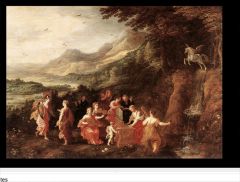
|
Joos de momper: Minerva with Muses Classical myth painting w/in a landscape Pegasus No patron info |
|
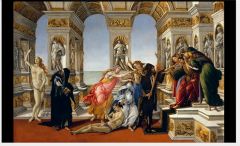
|
Botticelli : the calumny of apelles a recreation of Philostratus' description of ancient painting |
|
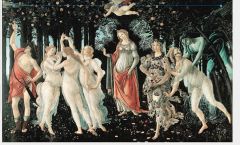
|
Botticelli: Primavera medici patron? euhemeristic treatment: athena as virgin mary Ancient and contemporary sources used Contemporary: alberti, lorenzo de medici, poliziano. |
|
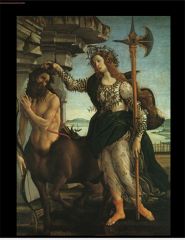
|
Pallas athena and the centaur Medici symbolism, difficult to identify goddess (not typical attributes Allegorica -> reason vs. instinct. (medici as rulers) |
|
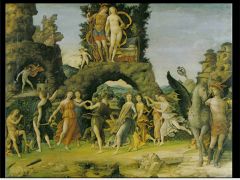
|
Mantegna: parnassus Patron: isebella d'esti presence of venus, mars, vulcan, cupid, apollo and muses. pegasus and hermes throws viewer on the meaning of the artwork |
|
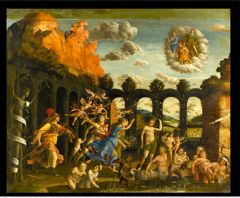
|
Mantegna: Minerva expelling the vices from the garden of virtue isebella d'este Allegorical |
|
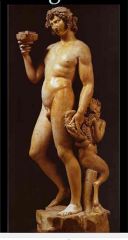
|
Michealangelo: bacchus patron: cardinal riario Symbolism, deliberate breaking of statue in order to pass it off as greek vine on head to relieve headache? communion associated with dionysos |
|
|
Ancient Sibyls (prophets) |
Varied in name and number location/origin erythrean and cumaean well known Sibylline oracles adopted into rome temple of jupiter embellished (consulted) euphemistic treatment (christian prophecies) faded from art/literature after mid 16th c. |
|
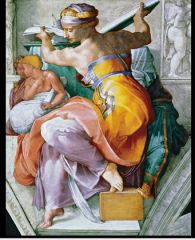
|
Libyan Sibyl |
|
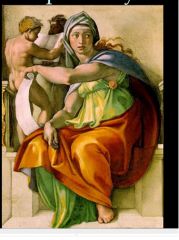
|
Delphic Sibyl |
|
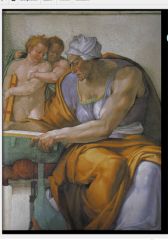
|
Cumaean sibyl (granted long life by the gods, but not youth) |
|
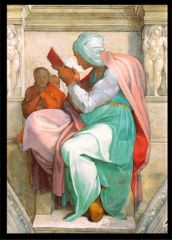
|
Persian Sibyl |
|
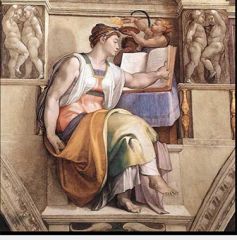
|
Erythraean Sibyl |
|
|
Thematic Program of the Stanza della Segnatura (Raphael) |
Philosophy -school of athens Justice- Jurisprudence poetry- parnassus theology - disputa |
|
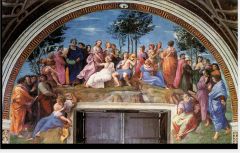
|
Parnassus Sappho and Petrarch modern and ancient poets |
|
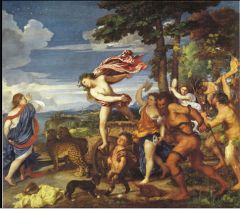
|
Titian: meeting of bacchus and ariadne Patron: alfonso d'este, (ducal palace) Subjects from PHilostratus III (imagines) -detailed descriptions of paintings Titian given an italian translation of the text -Ovid's Fasti and Metamorphoses and catullus |
|
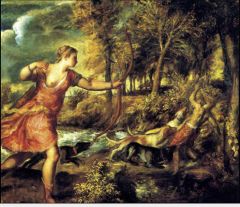
|
Titian: death of acteon the theme of "sight" being punished for seeing something he shouldn't have (even though it wasn't his fault.) |
|
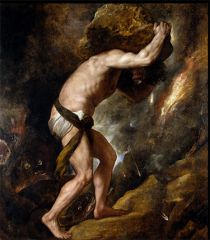
|
Titian: Sisyphus alludes to the christian idea of hell. allegorical |
|
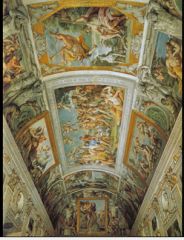
|
Annibale Carracci: the farnese gallery ceiling Patron: odorado Farnese "the love of the gods" playful, not really allegorical. illusionistic sculpture with flaws (replicating ancient sculpture) |
|

|
Annibale Carracci: Triumph of Bacchus and Ariadne written on by Giovan Pietro Bellori, Lives of the modern painters, sculptors, and architects - makes assumptions about painting, and woman on bot-right as earthly venus |
|
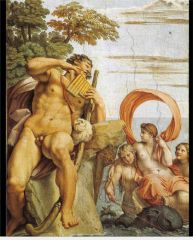
|
Annibale Carraci: Polyphemus and Galatea Lover scorned |
|
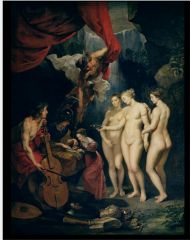
|
Peter Paul Rubens: The education of Maria de' Medici Symbolism: Waterfall, purity of motives maria's emblems Caduceus of Mercury, Florentine list of Maria's emblems 3 graces + apollo/hermes Pax optima rerum "peace the best of things concord, peace, unity, concilation |
|

|
Henry IV receiving the portrait of maria de' medici Jupiter and Juno + their emblems( peacock based on poetic description), france behind the king (marriage by proxy) "council of the gods" town on fire in the background metaphor for prodigious talent |
|
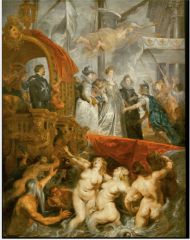
|
Rubens: The disembarkation of maria de' medici in marseilles historical, allegorical, mythological, knight of wants the story told as such |
|
|
What were two literary sources for Rubens? |
Cesar Rippa :iconologia and Valeriano : Hieroglyphica |
|
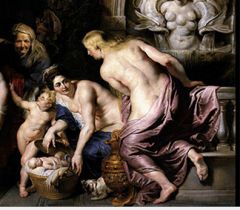
|
Rubens: discovery of the infant erechthonious Of the earth and Hephaestus gives it to keklops 3 daughters who throw themselves off cliff in story rubens painting draws from source of ovid Raven used to be a white bird, tattled on keklops daughters pan statue as moses focus on Herse (daughter) allude to later when hermes falls in love with her. 17th C antiquarian discourse |
|

|
Bernini: apollo and daphne -patron: cardinal seipione borghese "whoever in love pursues the delights of a fleeting form, fills his hands with leaves and plucks bitter berries." moral to the story gaze and touch |
|
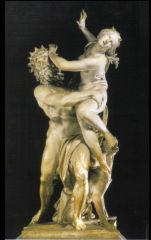
|
Bernini: pluto and proserpina abduction to hades progression of the story by the 180 degree viewing angle - Joy kenseth |
|
|
Velazquez- Mythical paintings |
doesn't paint gods as idealized |
|
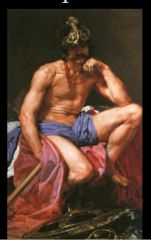
|
Velazquez: mars Downcast, pensive based on LUdovosi mars (roman copy of ancient statue) humanizes him-war has worn on mars derived inspiration from medieval mars "perez de maya, tilosoia secicta euhemeristic- as men |
|
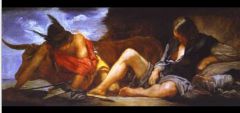
|
Velazquez: mercury and argus (story of zeus and IO) mercury-trickery the sirens song. |
|
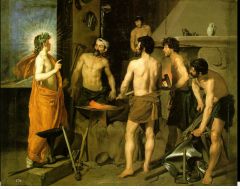
|
Velazquez: Vulcans forge being told by apollo Euhermeristic- more like a "genre piece" of a blacksmiths workshop |
|
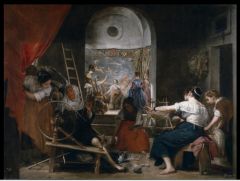
|
Velazquez: Athena and Arachne
huebrice. painting originally called spinners (misidentified) references bedeux's readings "skill of artists in court of king -by depicting motion "skill"<- statement of. 3 women in back are the graces notonly fates, but the four states of man mutibility of life, permanence of art. cat = moon, waking and waning, change. -impermanence of life. |
|
|
Bedaux's reading used by velazquez (who owned two copies |
dealth with alexander the great and apelles (artists and patronage of kings, that painting was part of the liberal arts. motion or life, phillip angel and franciscus junius` |
|
|
Velazquez's painting: arachne and athena |
uses stapleford and potters reading mutability of life -3 fates permanence of art - 3 graces references to rubens and titian bodegon in foreground fortune, the four states of man use of Cesare Ripa and catari |
|
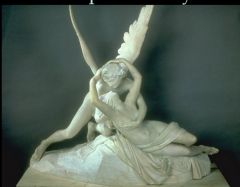
|
Canova: cupid and psyche Neo-classical extremely romanticized highly polished vessel is supposed to be a box psyche is nearly as beautiful as venus cupid wipes the sleep from her eyes (deathly sleep) |
|
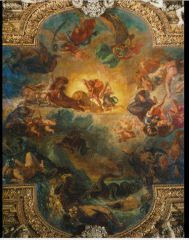
|
Delacroix: apollo slays python Romantic artist Gallerie d'apollon-louvre light conquering dark knowledge over ignorance |
|

|
Rosetti: proserpina artist uses the myth for himself pre-raphaelites contemplative, in the underworld based on jane morris=equating her to proserpina; was in an unhappy marriage light from upper world ivy-clinging detail pomegranate- captivity incense burner- goddess' attribute |
|
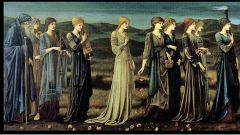
|
Edward burne-jones: the wedding of psyche -pre raphaelite idea came from william morris (earthly paradise) somber mood all look mostly the same hair of psyche is golden instruments more like props story shown at its low point, plays to the patrons likes lady carries torch of demeter |
|
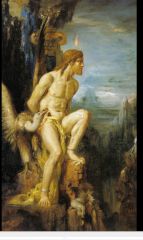
|
Moreau: Prometheus not depicted in a traditional sense shown as dignified, stoic. outlasted executioner, moving into the symbolist movement is christ-like |
|

|
Klimpt, Pallas Athena nude nike use of gold corinthian mask ancient vase imagery on back |

